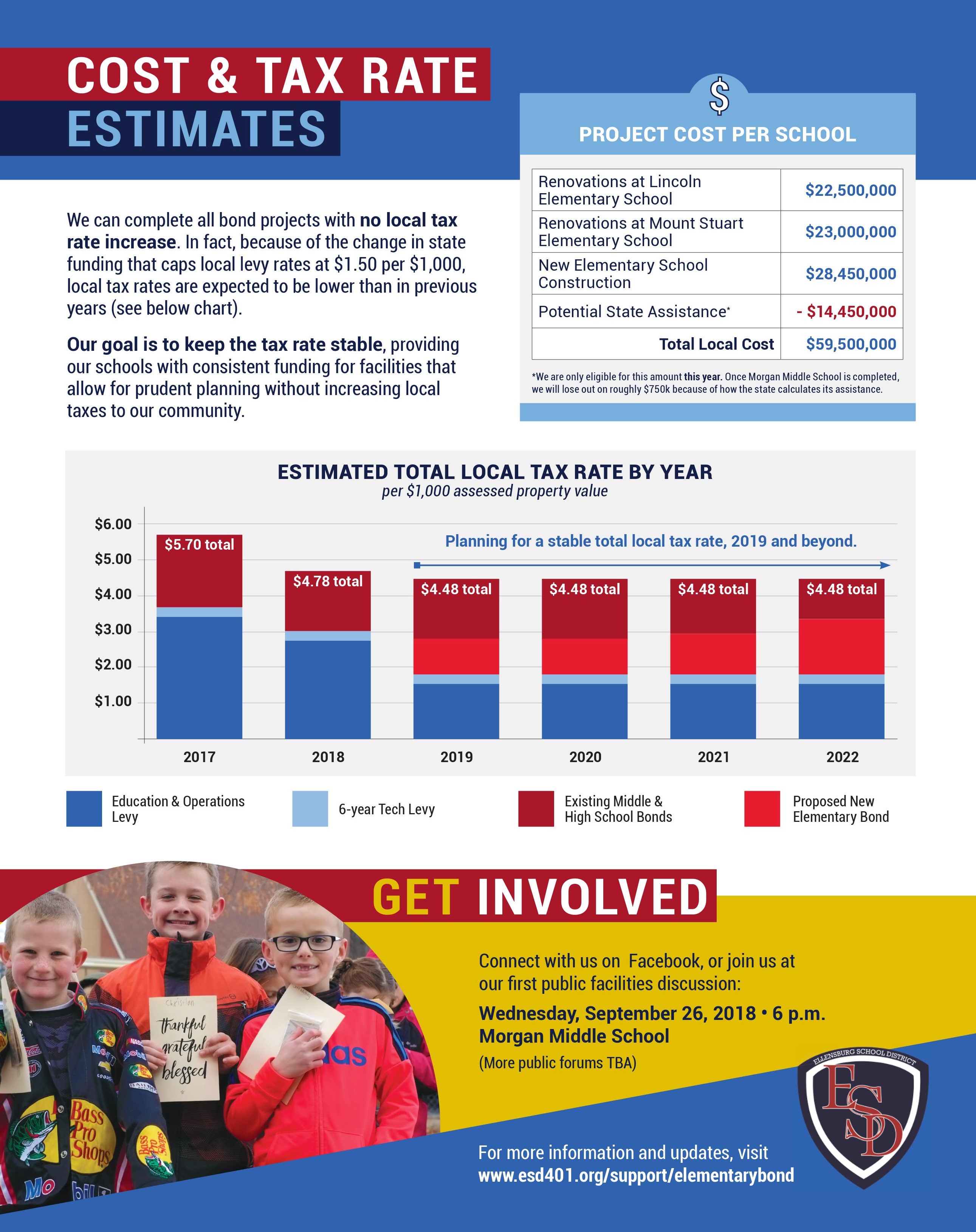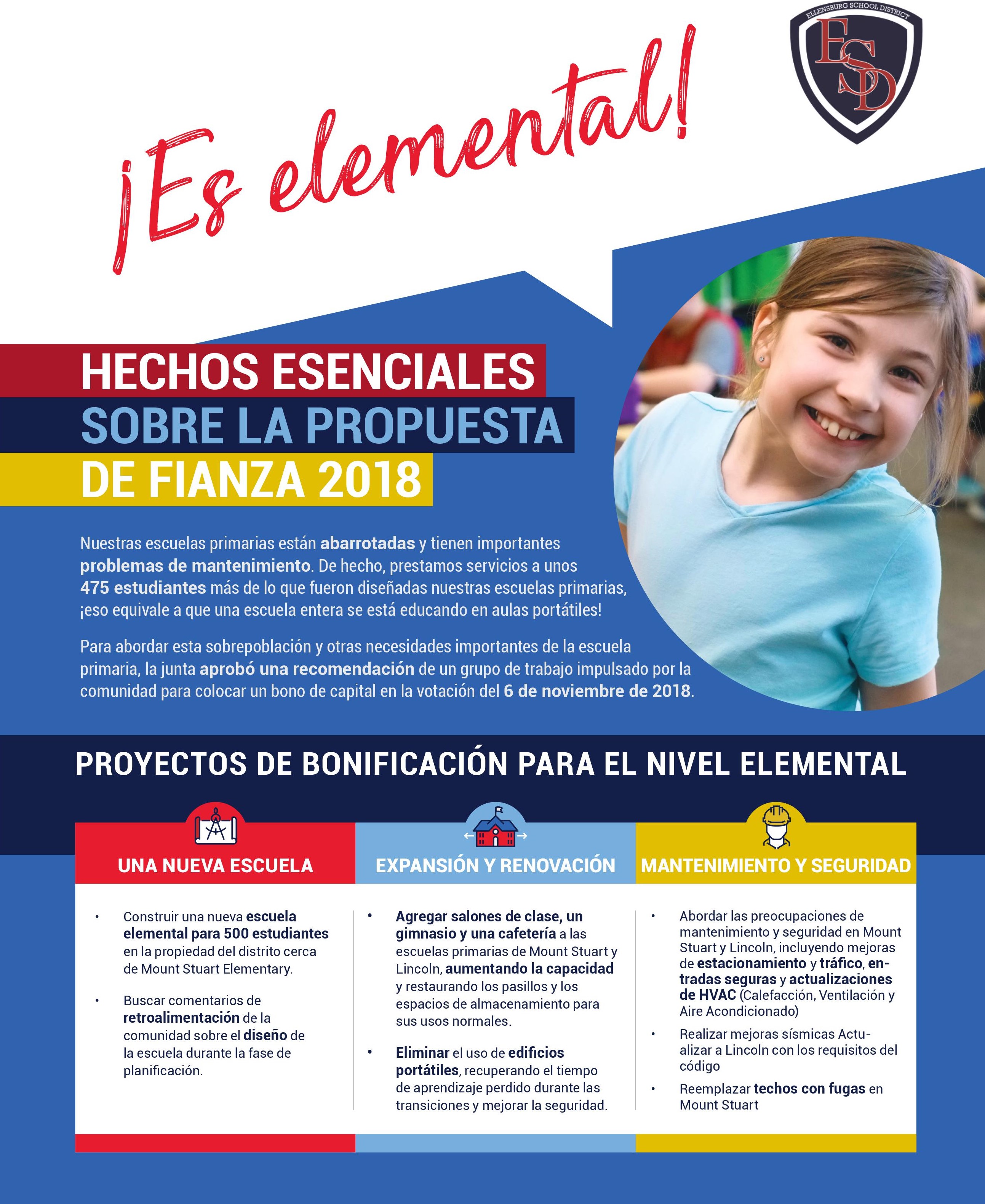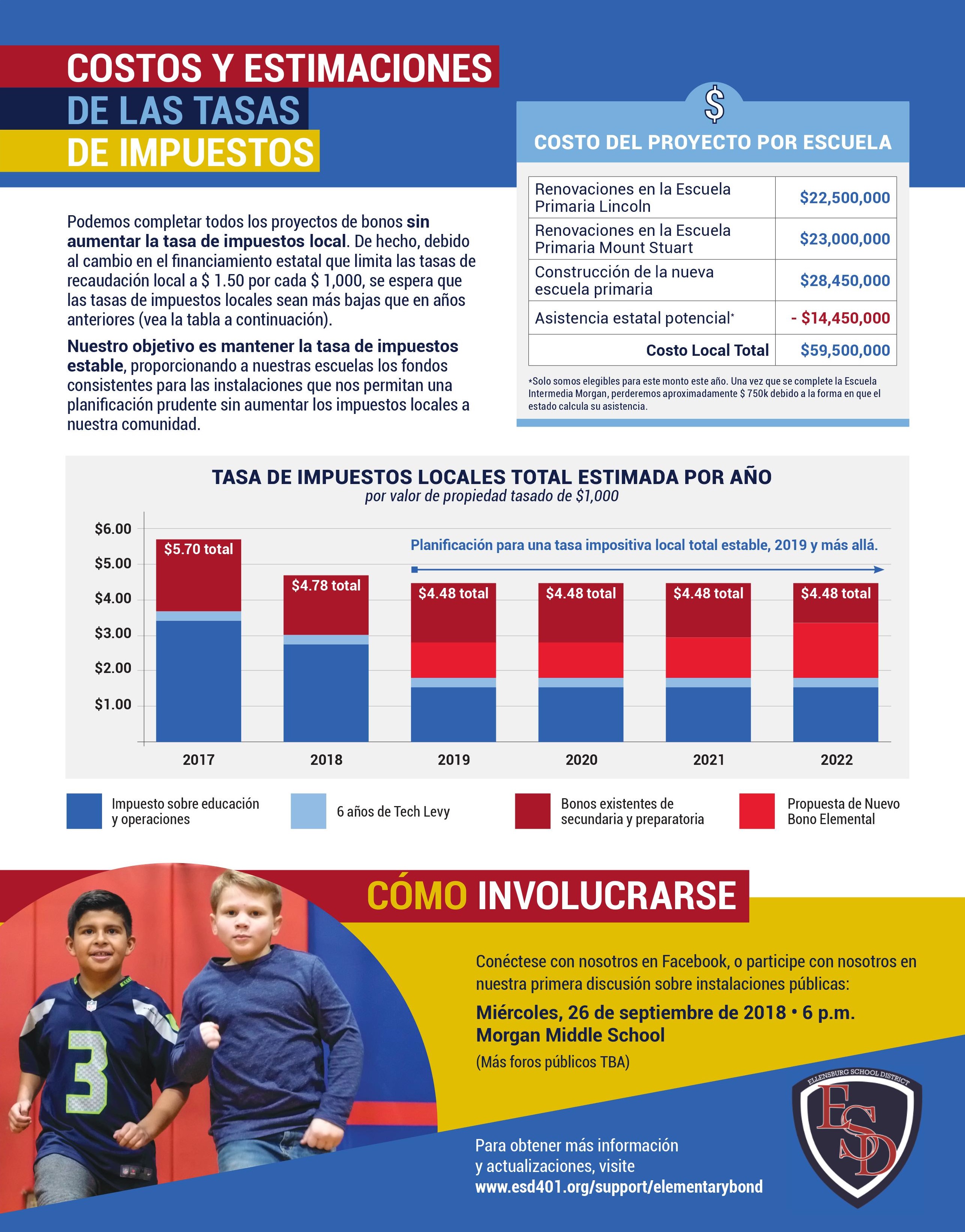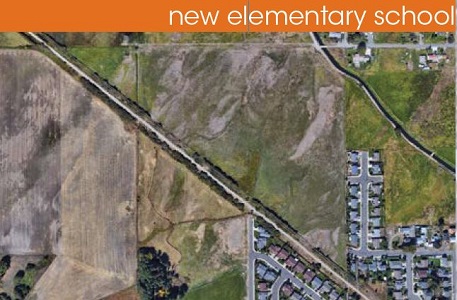What is the capacity vs. enrollment at each elementary school?
- Lincoln Elementary: 350* / 483**
- Mt. Stuart Elementary: 350* / 497**
- Valley View Elementary: 370* / 562**
- Approximately 472 students over capacity
*based on classroom size
**as of December, 2019
What are the major limitations in each building today?
- Multiple portables need fencing around them for security purposes
- Cafeteria size is over capacity
- Food service capacity for making meals
- Specialist schedules adapted (music, library, gym, art about every other week)
- Playground size
- Lack of gym space
- All classroom space has been utilized
- Closets are being used as classroom space
- Some teachers must use carts to deliver instruction to students
- Gym classes are not meeting state requirements for weekly PE class time
- No air conditioning (Lincoln and Mt. Stuart)
- Crowded playgrounds
- More people have had to be hired for playground supervision
What are enrollment projections?
- Kindergarten enrollment reached a peak of 273 students during the 2017-18 school year
- Since that time, kindergarten enrollment continues to average approximately 250 students
- Total K-12 student count increased 5.66% over the last five years, and is currently at 3,225 students
- Projections for future enrollment remains stable
What has been done with the buildings thus far to help the needs of our elementary learners?
Building Configuration:
- Four portable classrooms at Valley View
- Two portable classrooms at Mt. Stuart
- Two portable classrooms at Lincoln
- Converted auxiliary space to classrooms
- Displaced intervention programs (Title, Highly Capable) for additional classrooms
- Increased seating capacity in cafeterias
Lincoln Elementary School:
- Four classroom teachers
- Additional Intervention teacher
- Part-time specialist
- Assistant Principal
- Additional Paraprofessional support
- Incorporated Counselor in Specialist rotation
- Adapted Specialist schedule
Mt. Stuart Elementary School:
- Five classroom teachers
- Assistant Principal
- Part-time Specialist
- Additional Paraprofessional support
- Incorporated Counselor in Specialist rotation
- Adapted Specialist schedule
Valley View Elementary:
- Five Classroom teachers
- Assistant Principal
- Part-time Specialist
- Additional Paraprofessional support
- Math Lab Specialist
- Incorporated Counselor in Specialist rotation
- Adapted Specialist schedule
Why not add more portable classrooms?
Portables do not provide secure or controlled entrances, compromising the safety of our elementary students.
One of the things often forgotten is when we add portables to a building, the common areas of a building (offices, music rooms, counseling, gym, cafeteria, bathrooms) are built for a certain internal capacity. What happens when we add portables, then, is that the internal capacity cannot best meet the needs of learners.
Number of current classrooms in portables:
- Lincoln — 6
- Mt. Stuart — 8
- Valley View — 10
What renovations are needed at Lincoln and Mt. Stuart Elementary schools?
Mt. Stuart Elementary
Originally, the plan for Mt. Stuart Elementary School was to renovate by adding a new gym and classrooms, increasing the capacity from 350 to 500 students. Additionally, the plan was to add a secure entrance to the front of the school so visitors would not enter the school through the main hallway. The cafeteria was to be expanded to accommodate more students. A new HVAC system was to be installed improving heating efficiency, adding air conditioning and filtered air for our students. The addition of a new pitched roof was to be installed to rectify leaking issues and to make room for critical treatment and air handling systems. The drop off parking area for parents was to be separated from busing to improve student safety.
Now, with the plan of building a new Mt. Stuart Elementary building rather than renovation, all of the above mentioned issues are being addressed with a brand new building. The design of the new building incorporates capacity for 500 students, a secure entrance, an enlarged gym/cafeteria area to accommodate the new student capacity, an efficient HVAC system, and a parent drop-off/pick-up zone completely separated from the buses. Parents will enter and exit on the front side of the building via Cora Street while busing will be completely located on the back side of the school and accessed via 15th Avenue.
Lincoln Elementary
While continuing to build on the history and heritage of Lincoln Elementary and protecting our investment in the building, the following renovations are planned. Lincoln Elementary School will add a new gym and classrooms, increasing capacity from 350 to 450 students. The cafeteria will be relocated and expanded with a bigger kitchen and eating space for students. Seismic issues will be addressed to bring the school up to code. ADA issues will be addressed, including leveling floors and installing an elevator. Parking will be expanded at the front of the school. HVAC will be installed so that students can stay in school during smoke season and to rectify temperature issues of second floor classrooms. Other critical maintenance issues will also be addressed.
What is the capacity and location of the proposed new elementary school?
The proposed new school will be built on the 29 acres north of Mt. Stuart Elementary School, which our school district purchased in 2018. Capacity at the new elementary school will be 500 elementary students.
What is the Developmental Preschool? Is it required?
A Developmental Preschool is a service for students with special developmental needs. We are required to have the program and have housed the program at CWU for over 15 years. The Developmental Preschool will be located at Mt. Stuart Elementary.
How much do we pay in rent to CWU for Developmental Preschool?
Currently, the school district pays Central Washington University $13,400 per year.
What is the cost of the project?
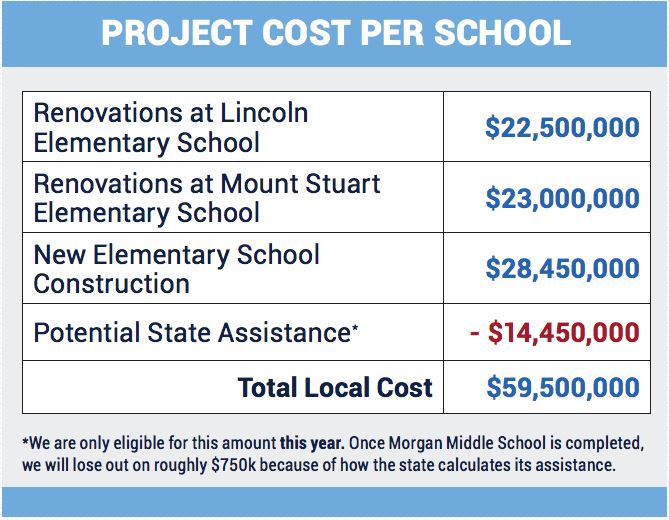
What is the difference between a bond and a levy?
Bonds are for building, levies are for learning!
A levy is a local tax. It supplements the general fund which pays for operational costs of the school district such as salaries, benefits, utilities, fuel costs, supplies, equipment, athletics, extracurricular activities and special programs. Levy dollars cannot be used for renovation or construction costs. A levy requires a simple majority voter approval (50% plus 1 vote) and can be approved for up to a four-year term.
Levies are raised from property tax and the levy rate is expressed in terms of dollars per thousand dollars of assessed property value. For example, a home assessed at $200,000 with a voter approved levy of $2.00 would equal $400 per year in taxes. ($200,000 / $1,000 X 2.00 = $400).
In Ellensburg for the 2018-19 school year, our local school levy makes up 12.2% (down from 17.3% last year) of our total revenue, the state contributes 78.2%, and federal 5.7%. The last 3.8% of our revenue is driven from local resources including donations, grants, fees, fines, and technology levy support.
A bond is voter approved debt that funds construction and renovation projects that levies, by law, cannot fund. You can think of a bond like a home mortgage, with long term payoff plans and low interest rates. A bond requires a 60% voter approval and can have a re-payment plan structured up to 40 years.
What is state assistance? How does it apply to this bond process?
The School Construction Assistance Program (SCAP) administered by the Office of Superintendent of Public Instruction (OSPI) provides funding assistance to school districts that are undertaking a major new construction or modernization project. Projects must meet eligibility requirements. School districts are responsible to secure local funding for construction projects. If eligible, the State provides partial funding based on formulas, allowances, and costs related to certain aspects of a construction project called recognized project costs.
We will receive approximately $16,740,000 in state assistance, as opposed to our original estimate of $14.5 million. State assistance helps reduce the tax burden of the voters by supplementing the bond through state funding.
How will this impact my taxes?
With the recent McCleary decision ordering the state to fully fund K-12 public schools as required by Article IX of the Washington Constitution and capping local levies at $1.50 per thousand of assessed value, and the high school bond being paid off in 2021, this bond will result in NO INCREASE to the local tax rate.
Local taxes are based on assessed property value. Due to the McCleary decision, in 2018 the school district local levy, known as the education and operations levy (E&O), was limited to $1.50 per thousand of assessed value. In 2017, the E&O levy was $3.47 per $1,000 of assessed value. This year, the E&O levy is $1.50 per $1,000 of assessed value, keeping our total levy rate at or below $4.50 per $1,000 as promised to voters. In 2019 the Legislature increased the cap to $2.50.
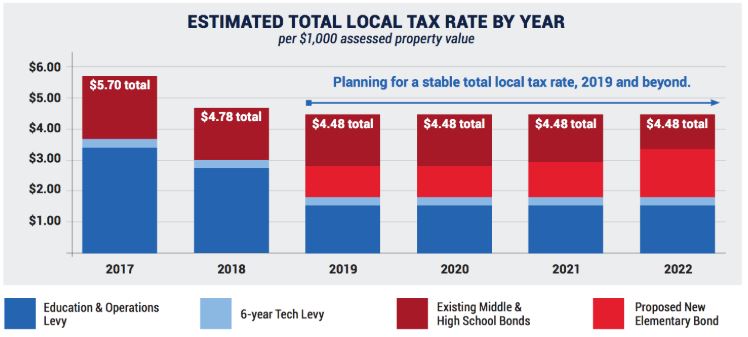
How can I get more information?
We are here to answer your questions about the bond, existing and planned facilities, enrollment, tax rate or anything else you’d like to discuss.
Use the form below to reach us and continue to check this site and our Facebook page for updates and public forum information.

